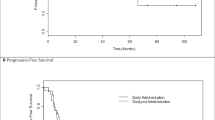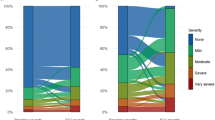Abstract
Introduction
Evidence suggests that many cancer chemotherapy patients who are candidates for colony-stimulating factor (CSF) prophylaxis do not receive it or receive it inconsistent with guidelines, and that such patients have a higher risk of febrile neutropenia hospitalization (FNH). Little is known about the number and consequences of FNH by use/patterns of CSF prophylaxis in US clinical practice.
Methods
A retrospective cohort design and private healthcare claims data were employed. Study population comprised adults who received a chemotherapy course with a high-risk regimen, or an intermediate-risk regimen (if ≥1 FN risk factor present), for non-metastatic breast cancer or non-Hodgkin’s lymphoma (NHL); each chemotherapy cycle within the course and each FNH episode within the cycles were identified. Consequences included mortality, inpatient days, and costs (US$2013) during FNH. Use (yes/no) and patterns (agent, administration day/duration) of CSF prophylaxis were evaluated within cycles in which FNH episodes occurred.
Results
Among all FNH episodes (n=6,355; 109 episodes per 1,000 patients), 41.3% (95% CI: 40.1-42.5) occurred among patients who did not receive CSF prophylaxis in that cycle, and 8.8% (8.1-9.5) occurred among those who received CSF prophylaxis on the same day as chemotherapy. Among FNH episodes occurring in patients who received daily CSF agents (2% of CSF use), 56.1% (44.1-68.0) received prophylaxis <7 days during the cycle. Results for FNH consequences were comparable.
Conclusions
In this retrospective evaluation, one-half of FNH episodes, outcomes, and costs among cancer chemotherapy patients who were candidates for CSF prophylaxis occurred in those who either did not receive it or received it inconsistent with guidelines.
Similar content being viewed by others
References
Weycker D, Malin J, Edelsberg J, Glass A, Gokhale M, Oster G (2008) Cost of neutropenic complications of chemotherapy. Ann Oncol 19(3):454–460
Kuderer NM, Dale DC, Crawford J, Cosler LE, Lyman GH (2006) Mortality, morbidity, and cost associated with febrile neutropenia in adult cancer patients. Cancer 106:2258–2266
Smith TJ, Khatcheressian J, Lyman GH, Ozer H, Armitage JO, Balducci L et al (2006) 2006 update of recommendations for the use of white blood cell growth factors: an evidence-based clinical practice guideline. J Clin Oncol 24(19):3187–3205
Caggiano V, Weiss RV, Rickert TS, Linde-Zwirble WT (2005) Incidence, cost and mortality of neutropenia hospitalization associated with chemotherapy. Cancer 103:1916–1924
Network NCC: (2015) NCCN Clinical Practice Guidelines in Oncology (NCCN Guidelines) Myeloid Growth Factors, Version 2.
Neulasta (Pegfilgrastim) (2015) Prescribing Information. Amgen Inc.,
Neupogen (Filgrastim) (2015) Prescribing Information. Amgen Inc.
Granix (tbo-filgrastim) (2015) Prescribing Information. Teva Pharmaceuticals
Vogel CL, Wojtukiewicz MZ, Carroll RR, Tjulandin SA, Barajas-Figueroa LJ, Wiens BL et al (2005) First and subsequent cycle use of pegfilgrastim prevents febrile neutropenia in patients with breast cancer: a multicenter, double-blind, placebo-controlled phase III study. J Clin Oncol 23(6):1178–1184
Green MD, Koelbl H, Baselga J, Galid A, Guillem V, Gascon P et al (2003) A randomized double-blind multicenter phase III study of fixed-dose single-administration pegfilgrastim versus daily filgrastim in patients receiving myelosuppressive chemotherapy. Ann Oncol 14(1):29–35
Holmes FA, Jones SE, O'Shaughnessy J, Vukelja S, George T, Savin M et al (2002) Comparable efficacy and safety profiles of once-per-cycle pegfilgrastim and daily injection filgrastim in chemotherapy-induced neutropenia: a multicenter dose-finding study in women with breast cancer. Ann Oncol 13:903–909
Trillet-Lenoir V, Green J, Manegold C, Von Pavel J, Gatzemeier U, Lebeau B et al (1993) Recombinant granulocyte colony stimulating factor reduces the infectious complications of cytotoxic chemotherapy. Eur J Cancer 29A:319–324
Crawford J, Ozer H, Stoller R, Johnson D, Lyman G, Tabbara I et al (1991) Reduction by granulocyte colony-stimulating factor of fever and neutropenia induced by chemotherapy in patients with small-cell lung cancer. N Engl J Med 325:164–170
Leukine (Sargramostim) (2009) Package Insert. Pittsburgh, PA, Bayer Inc,
Weycker D, Malin J, Barron R, Edelsberg J, Kartashov A, Oster G (2012) Comparative effectiveness of filgrastim, pegfilgrastim, and sargramostim as prophylaxis against hospitalization for neutropenic complications in cancer chemotherapy patients. Am J Clin Oncol 35(3):267–274. doi:10.1097/COC.0b013e31820dc075
Heaney ML, Toy EL, Vekeman F, Laliberté F, Dority BL, Perlman D, Barghout V, Duh MS (2009) Comparison of hospitalization risk and associated costs among patients receiving sargramostim, filgrastim, and pegfilgrastim for chemotherapy-Induced neutropenia. Cancer 115:4839–4848
Weycker D, Li X, Figueredo J, Barron R, Tzivelekis S, Hagiwara M (2015a) Risk of chemotherapy-induced febrile neutropenia in cancer patients receiving pegfilgrastim prophylaxis: Does timing of administration matter? Supportive Care in Cancer. doi:10.1007/s00520-015-3036-7
Weycker D, Li X, Barron R, Li Y, Reiner M, Kartashov A et al (2015b) Risk of chemotherapy-induced febrile neutropenia with early discontinuation of pegfilgrastim prophylaxis in US clinical practice. Supportive Care in Cancer. doi:10.1007/s00520-015-3039-4
Langeberg WJ, Siozon CC, Page JH, Morrow PK, Chia VM (2014) Use of pegfilgrastim primary prophylaxis and risk of infection, by chemotherapy cycle and regimen, among patients with breast cancer or non-Hodgkin's lymphoma. Support Care Cancer 22:2167–2175. doi:10.1007/s00520-014-2184-5
Aarts MJ, Peters FP, Mandigers CM, Dercksen MW, Stouthard JM, Nortier HJ et al (2013) Primary granulocyte colony-stimulating factor prophylaxis during the first two cycles only or throughout all chemotherapy cycles in patients with breast cancer at risk for febrile neutropenia. J Clin Oncol 31:4290–4296
Tan H, Tomic K, Hurley D, Daniel G, Barron R, Malin J (2011) Comparative effectiveness of colony-stimulating factors for febrile neutropenia: a retrospective study. Curr Med Res Opin 27:79–86
Potosky A, Malin J, Kim B, Chrischilles E, Makgoeng S, Howlader N, Weeks J (2011) Use of colony-stimulating factors with chemotherapy: opportunities for cost savings and improved outcomes. J Natl Cancer Inst 103(12):979–982
Weycker D, Malin J, Kim J, Kim J, Barron R, Edelsberg J et al (2009) Risk of hospitalization for neutropenic complications of chemotherapy in patients with primary solid tumors receiving pegfilgrastim or filgrastim prophylaxis: a retrospective cohort study. Clin Ther 31:1069–1081
Schuman SI, Lambrou N, Robson K, Glück S, Myriounis N, Pearson JM et al (2009) Pegfilgrastim dosing on same day as myelosuppressive chemotherapy for ovarian or primary peritoneal cancer. J Support Oncol 7:225–228
Morrison VA, Wong M, Hershman D, Campos LT, Ding B, Malin J (2007) Observational study of the prevalence of febrile neutropenia in patients who received filgrastim or pegfilgrastim associated with 3-4 week chemotherapy regimens in community oncology practices. J Manag Care Pharm 13(4):337–348
Naeim A, Friedman L, Pasta DJ (2007) Prophylaxis of chemotherapy-induced neutropenia: Patterns of care in U.S. community oncology practices. Journal of Clinical Oncology 25 (Abstract #9123)
Lokich JJ (2006) Same day Pegfilgrastim and CHOP chemotherapy for non-Hodgkin lymphoma. Am J Clin Oncol 29:361–363
Weycker D, Hackett J, Edelsberg JS, Oster G, Glass AG (2006) Are shorter courses of filgrastim prophylaxis associated with increased risk of hospitalization? Ann Pharmacother 40:402–407
Hoffman P (2005) Administration of pegfilgrastim on the same day or next day of chemotherapy. ASCO American Society of Clinical Oncology Annual Meeting (Abstract #8137)
Hershman D, Hurley D, Wong M, Morrison VA, Malin JL (2009) Impact of primary prophylaxis on febrile neutropenia within community practices in the US. J Med Econ 12:203–210
Henk HJ, Becker L, Tan H, Yu J, Kavati A, Naeim A et al (2013) Comparative effectiveness of pegfilgrastim, filgrastim, and sargramostim prophylaxis for neutropenia-related hospitalization: two US retrospective claims analyses. J Med Econ 16:160–168
Burris HA, Belani CP, Kaufman PA, Gordon AN, Schwartzberg LS, Paroly WS et al (2010) Pegfilgrastim on the same day versus next day of chemotherapy in patients with breast cancer, non-small-cell lung cancer, ovarian cancer, and non-hodgkin's lymphoma: Results of four multicenter, double-blind, randomized phase ii studies. J Oncol Pract 6:133–140
Cheng C, Gallagher EM, Yeh JY, Earl MA (2014) Rates of febrile neutropenia with pegfilgrastim on same day versus next day of CHOP with or without rituximab. Anticancer Drugs 25:964–969
Skarlos DV, Timotheadou E, Galani E, Samantas E, Grimani I, Lianos E et al (2009) Pegfilgrastim administered on the same day with dose-dense adjuvant chemotherapy for breast cancer is associated with a higher incidence of febrile neutropenia as compared to conventional growth factor support: matched case-control study of the Hellenic Cooperative Oncology Group. Oncology 77:107–112
Whitworth JM, Matthews KS, Shipman KA, Numnum TM, Kendrick JE, Kilgore LC et al (2009) The safety and efficacy of day 1 versus day 2 administration of pegfilgrastim in patients receiving myelosuppressive chemotherapy for gynecologic malignancies. Gynecol Oncol 112:601–604
Scott SD, Chrischilles EA, Link BK, Delgado DJ, Fridman M, Stolshek BS (2003) Days of prophylactic filgrastim use to reduce febrile neutropenia in patients with non-Hodgkin’s lymphoma treated with chemotherapy. J Manag Care Pharm 9:15–21
US Department of Health and Human Services (2009) Code of Federal Regulations: Title 45, public welfare; Part 46, protection of human subjects. http://www.hhs.gov/ohrp/humansubjects/guidance/45cfr46.html. Accessed 4 July 2013.
Schnipper L, Smith T, Raghavan D, Blayney D, Ganz P, Mulvey T, Wollins D (2012) American Society of Clinical Oncology identifies five key opportunities to improve care and reduce costs: the top five list for oncology. J Clin Oncol 30(14):1715–1724
Waters G, Corrigan P, Gatesman M, Smith T (2013) Comparison of pegfilgrastim prescribing practice to national guidelines at a university hospital outpatient oncology clinic. J Oncol Pract 9(4):203–206
Kuderer N, Lyman G (2011) Personalized medicine and cancer supportive care: appropriate use of colony-stimulating factor support of chemotherapy. J Natl Cancer Inst 103(12):910–913
Weycker D, Sofrygin O, Seefeld K, Deeter RG, Legg J, Edelsberg J (2013) Technical evaluation of methods for identifying chemotherapy-induced febrile neutropenia in healthcare claims databases. BMC Health Serv Res 13
Acknowledgments
None.
Authors’ Contributions
Authorship was designated based on the guidelines promulgated by the International Committee of Medical Journal Editors (2004). All persons who meet criteria for authorship are listed as authors on the title page. The contribution of each of these persons to this study is as follows: (1) conception and design (all authors), acquisition of data (X. Li, Weycker), analysis or interpretation of data (all authors); and (2) preparation of manuscript (Atwood, Weycker), critical review of manuscript (X. Li, Tzivelekis, Garcia, Y. Li, Reiner, Lyman). The study sponsor reviewed the study research plan and study manuscript; data management, processing, and analyses were conducted by PAI, and all final analytic decisions were made by study investigators. All authors have read and approved the final version of the manuscript.
Author information
Authors and Affiliations
Corresponding author
Ethics declarations
Conflict of Interest
The authors declare that they have no conflict interests.
Disclosures
Funding for this research was provided by Amgen Inc. to Policy Analysis Inc. (PAI).
Declaration of Funding
Funding for this research was provided by Amgen Inc. to Policy Analysis Inc. (PAI).
Declaration of Financial/Other Relationships
Derek Weycker and Mark Atwood are employed by PAI. Spiros Tzivelekis, Jacob Garcia, Yanli Li, and Maureen Reiner are employed by, and are stockholders in, Amgen Inc. Xiaoyan Li was employed by Amgen during the conduct of this research. Gary Lyman is Co-Director at the Hutchinson Institute for Cancer Outcomes Research and Professor of Medicine at the University of Washington School of Medicine.
Electronic supplementary material
Esm 1
(DOCX 2164 kb)
Rights and permissions
About this article
Cite this article
Weycker, D., Li, X., Tzivelekis, S. et al. Burden of Chemotherapy-Induced Febrile Neutropenia Hospitalizations in US Clinical Practice, by Use and Patterns of Prophylaxis with Colony-Stimulating Factor. Support Care Cancer 25, 439–447 (2017). https://doi.org/10.1007/s00520-016-3421-x
Received:
Accepted:
Published:
Issue Date:
DOI: https://doi.org/10.1007/s00520-016-3421-x




